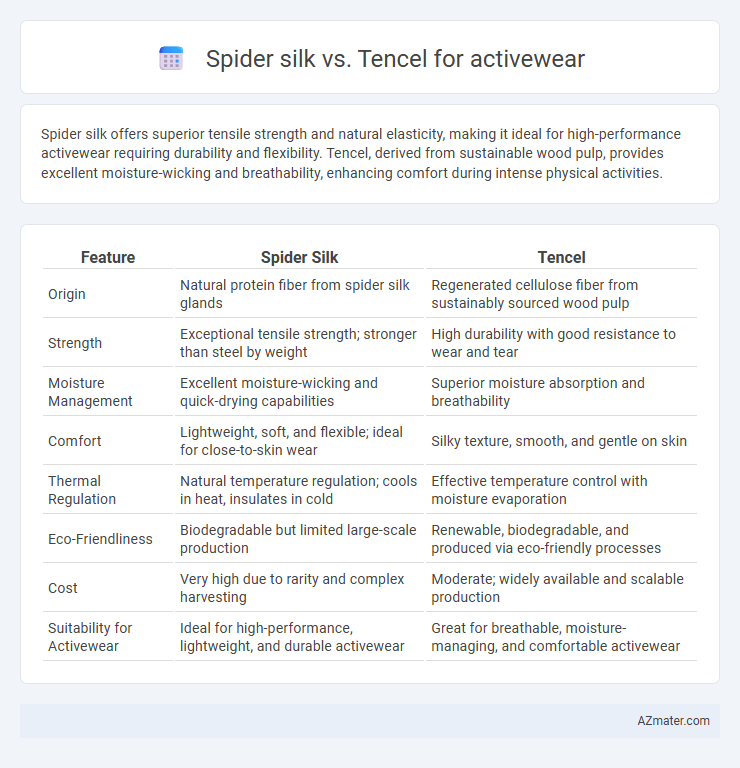Spider silk offers superior tensile strength and natural elasticity, making it ideal for high-performance activewear requiring durability and flexibility. Tencel, derived from sustainable wood pulp, provides excellent moisture-wicking and breathability, enhancing comfort during intense physical activities.
Table of Comparison
| Feature | Spider Silk | Tencel |
|---|---|---|
| Origin | Natural protein fiber from spider silk glands | Regenerated cellulose fiber from sustainably sourced wood pulp |
| Strength | Exceptional tensile strength; stronger than steel by weight | High durability with good resistance to wear and tear |
| Moisture Management | Excellent moisture-wicking and quick-drying capabilities | Superior moisture absorption and breathability |
| Comfort | Lightweight, soft, and flexible; ideal for close-to-skin wear | Silky texture, smooth, and gentle on skin |
| Thermal Regulation | Natural temperature regulation; cools in heat, insulates in cold | Effective temperature control with moisture evaporation |
| Eco-Friendliness | Biodegradable but limited large-scale production | Renewable, biodegradable, and produced via eco-friendly processes |
| Cost | Very high due to rarity and complex harvesting | Moderate; widely available and scalable production |
| Suitability for Activewear | Ideal for high-performance, lightweight, and durable activewear | Great for breathable, moisture-managing, and comfortable activewear |
Introduction to Spider Silk and Tencel
Spider silk, known for its remarkable tensile strength and natural elasticity, offers lightweight durability and breathability ideal for activewear. Tencel, a sustainable fabric derived from eucalyptus wood pulp, provides moisture-wicking properties and a silky-soft texture that enhances comfort during physical activities. Both materials represent innovative options in performance textiles, combining eco-friendly production with advanced functionality for high-performance sportswear.
Key Properties of Spider Silk
Spider silk boasts exceptional tensile strength, surpassing steel by weight, making it incredibly durable for activewear applications. Its remarkable elasticity allows for superior flexibility and comfort during intense physical activity. Additionally, spider silk exhibits natural moisture-wicking and antimicrobial properties, enhancing breathability and hygiene in performance apparel.
Key Features of Tencel Fiber
Tencel fiber, derived from sustainably sourced eucalyptus wood pulp, offers exceptional moisture-wicking properties and breathability, making it ideal for activewear that requires quick drying and odor control. Its natural softness and high tensile strength provide comfort and durability, while its biodegradability ensures an eco-friendly alternative to synthetic fibers. The fiber's ability to regulate temperature and resist wrinkles enhances performance and maintains a polished look during intense physical activities.
Moisture Management Comparison
Spider silk fibers exhibit exceptional moisture-wicking properties, rapidly drawing sweat away from the skin and promoting quick evaporation, which keeps the body dry during intense workouts. Tencel, derived from sustainably sourced eucalyptus trees, offers superior breathability and moisture absorption, retaining less water than cotton while maintaining softness and comfort. When comparing moisture management, spider silk excels in rapid moisture transport and antibacterial qualities, whereas Tencel provides enhanced moisture retention control with a smooth, cooling effect ideal for prolonged activewear use.
Strength and Durability Differences
Spider silk exhibits exceptional tensile strength, surpassing steel by weight, making it incredibly durable and resistant to wear and tear in activewear applications. Tencel, derived from sustainably sourced eucalyptus, offers moderate strength alongside moisture-wicking properties but tends to wear out faster under intense physical activity. The superior strength and elasticity of spider silk fibers provide longer-lasting performance and resilience compared to Tencel in high-stress activewear environments.
Breathability and Comfort Level
Spider silk exhibits exceptional breathability due to its natural protein structure that efficiently regulates temperature and moisture, making it highly suitable for activewear. Tencel, derived from sustainably sourced wood pulp, also offers excellent moisture-wicking properties and softness, ensuring superior comfort during physical activities. While spider silk provides a lightweight, durable fabric with natural elasticity, Tencel excels in softness and environmental sustainability, striking a balance between performance and comfort.
Sustainability and Environmental Impact
Spider silk and Tencel both offer sustainable alternatives for activewear, with spider silk being a biodegradable protein fiber derived from genetically engineered microorganisms and Tencel produced from responsibly sourced eucalyptus wood through a closed-loop process. Spider silk boasts exceptional strength and elasticity while requiring minimal water and pesticides, significantly reducing environmental impact compared to conventional fibers. Tencel's production emphasizes low energy consumption and biodegradability, making it an eco-friendly choice with a lower carbon footprint and enhanced moisture management properties suited for activewear.
Performance in Athletic Activities
Spider silk outperforms Tencel in athletic activities due to its exceptional tensile strength and elasticity, which provide superior durability and flexibility during intense physical movements. Tencel offers excellent moisture-wicking properties and breathability but lacks the resilience and quick recovery of spider silk fibers under continuous stress. The combination of spider silk's lightweight nature and high tensile strength makes it ideal for activewear requiring robust performance and sustained comfort.
Cost and Availability for Activewear
Spider silk fibers boast exceptional strength and moisture-wicking properties but remain prohibitively expensive and scarce due to complex bioengineering processes, limiting widespread use in activewear. Tencel, derived from sustainable wood pulp, offers affordable pricing and broad availability, making it a practical choice for mass-produced activewear with good breathability and softness. Manufacturers often prefer Tencel over spider silk when balancing performance, cost-efficiency, and large-scale production demands in the activewear market.
Future Prospects in Activewear Fabrics
Spider silk exhibits exceptional tensile strength, elasticity, and biodegradability, positioning it as a groundbreaking material for future activewear designed to enhance performance and sustainability. Tencel, derived from sustainably sourced eucalyptus trees, offers superior moisture-wicking, breathability, and eco-friendly production, making it a favored choice for eco-conscious activewear brands. Emerging hybrid textiles combining spider silk's durability with Tencel's comfort and environmental benefits are expected to revolutionize activewear by delivering high-performance, sustainable fabrics.

Infographic: Spider silk vs Tencel for Activewear
 azmater.com
azmater.com